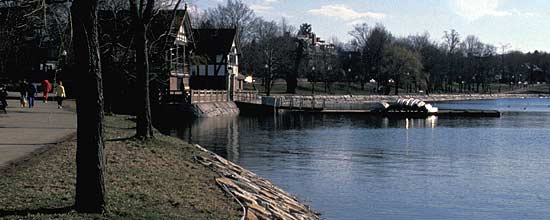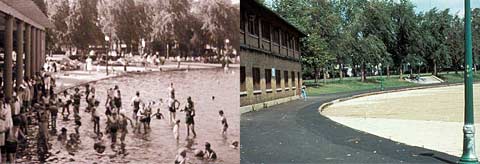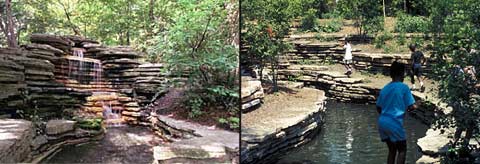

Guidelines for Rehabilitating Cultural Landscapes
Water Features

Identify, Retain, and Preserve Historic Features and Materials
![]()
Identifying, retaining and preserving existing water features and water sources such as retention ponds, pools, and fountains prior to beginning project work. Documenting the shape, edge and bottom condition/material; water level, sound and reflective qualities; and associated plant and animal life, and water quality.
Evaluating the condition, and, where applicable, the evolution of water features over time. For example, assessing water quality and/or utilizing archeological techniques to determine the changing path of a watercourse.
![]()
Executing project work that impacts water features, and associated hydrology, without undertaking an existing conditions survey. For example, filling in a pond that was historically used for farm or recreation purposes.
Executing project work without understanding its impact on water features. For example, placing a section of stream in a culvert or concrete channel.
Protect and Maintain Historic Features and Materials
![]()
Protecting and maintaining water features by use of non-destructive methods in daily, seasonal and cyclical tasks. For example, cleaning leaf litter or mineral deposits from drainage inlets or outlets.
Maintaining a water feature’s mechanical, plumbing and electrical systems to insure appropriate depth of water or direction of flow. For example, maintaining the timing and sequencing mechanisms for irrigation systems.
![]()
Failing to undertake preventive maintenance of water features and materials.
Utilizing maintenance methods which destroy or degrade water features, for example, the use of harsh chemical additives for maintaining water quality.
Allowing mechanical systems to fall into a state of disrepair, resulting in changes to the water feature. For example, failing to maintain a pool’s aeration system thus leading to algae growth.

Prior to rehabilitation project work, this five-acre wading pool in Martin Luther King Park in Buffalo, New York, was evaluated to understand its historic design and use. It was determined that, although the pool and poolhouse were in disrepair, they possessed a high level of integrity. (LANDSCAPES)
Repair Historic Features and Materials
![]()
Repairing water features by reinforcing materials or augmenting mechanical systems. For example, patching a crack in an pond liner or repairing a failed pump mechanism.
![]()
Replacing or removing features or systems when repair is possible. For example, abandoning a silted-in retention pond.
Replace Deteriorated Historic Materials and Features
![]()
Using existing physical evidence of form, depth and detailing to reproduce a deteriorated water feature. If using the same kind of material is not technically, economically, or environmentally feasible, then a compatible substitute material may be considered. For example, replacing a lead pond liner with one made of plastic.
![]()
Removing a water feature that is unrepairable and not replacing it, or replacing it with a new feature that does not convey the same visual appearance. For example, replacing a single orifice nozzle with a spray nozzle, thus changing the fountain’s historic character from a singular stem of water to a mist-like stream.
Design for the Replacement of Missing Historic Features
![]()
Designing and installing a new water feature when the historic feature is completely missing. It may be an accurate restoration using historical, pictorial and physical documentation; or be a new design that is compatible with the historic character of the landscape. For example, replacing a lost irrigation feature using materials that convey the same visual appearance.
![]()
Creating a false historical appearance because the replaced feature is based on insufficient historical, pictorial and physical documentation.
Introducing a new design that is incompatible with the historic character of the landscape. For example, replacing a natural pond with a manufactured pool.

Rehabilitation work in Columbus Park included the South waterfall, cascades, rocky brook and associated landscape in Jens Jensen’s most extant and authenticated park in Chicago, Illinois. Recognizing that park visitors would wish to gain access to the water’s edge, plant materials were installed with an additional set back and additional stones were provided to accommodate safe passage -- all to insure the health and vigor of new plantings. This work was done while still protecting and maintaining character-defining features, materials and finishes. (Chicago Park District Archives, ca. 1938 and NPS, 1995)
Alterations/Additions for the New Use
![]()
Designing and installing a compatible new water feature when required by the new use to assure the preservation of historic character of the landscape. For example, siting a new retention basin in a secondary, or non-significant space in the cultural landscape.
![]()
Placing a new water feature where it may cause damage, or is incompatible with the historic character, such as adding a water slide.
Locating any new water feature in such a way that it detracts from or alters the historic character of the landscape. For example, installing a “period” fountain where one never existed.
Introducing a new water feature which is in an appropriate location, but is visually incompatible in terms of its shape, edge, and bottom condition/material; or water level, movement, sound, and reflective quality. For example, introducing a wading pool in a non-significant space, but utilizing non traditional materials and colors.
[top] Jamaica Pond has an ongoing erosion problem, exacerbated by wave action. To stabilize the shoreline, this stone rip-rap was modeled after the original detail implemented by the Olmsted firm. (Pressley Associates and Boston Parks & Recreation)